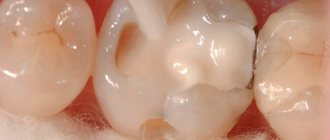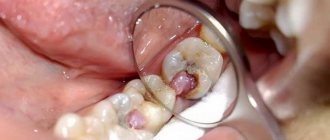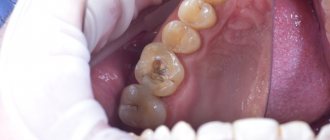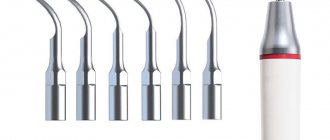Tooth filling is one of the most common and well-established dental procedures, however, it also has its own nuances and subtleties. We tell you what you should pay attention to, what filling to choose and how the filling is installed on a tooth at the ViDentis clinic.
Almost every person has had to deal with a tooth filling in their life. This is a simple and effective procedure, which consists of removing damaged areas of enamel and its further restoration using special compounds. The cost of installing a filling is low, so this treatment is used quite often.
Installing a filling on a tooth: indications
It is recommended to put a filling in dentistry mainly for caries. This is a pathological process that consists of the slow, gradual destruction of tooth tissue under the influence of bacteria contained in soft plaque. As a result of their vital activity, these bacteria produce acids that destroy calcium in tooth enamel. The enamel becomes fragile and is destroyed, forming carious cavities, which, without proper treatment, gradually increase more and more.
By installing a filling on a tooth, you can restore a crown that has been destroyed by caries by about a third. If the tooth tissues are more damaged, then other methods of their restoration are used.
However, caries is not the only reason to get a filling in dentistry. Filling can also correct:
- cracks and chips of enamel;
- traumatic injuries;
- erased enamel (with bruxism).
Popular Composite Seals
Composite fillings are commonly used to fill teeth . They consist of active dimethylacrylic polymerizing resins and inactive filler particles. Among the composite fillings the following can be distinguished:
• light-curing fillings, • chemically curing fillings, • thermosetting fillings.
The advantage of their use is high resistance to chewing pressure, high cosmetic qualities, preservation of contrast on X-ray images and excellent adhesion to enamel. They are structurally compatible with tooth tissues.
What types of fillings are there?
There are several types of filling materials. The type of material determines the cost of installing a filling on a tooth, how long it will last, and how good it will look.
- Cement fillings have been popular for some time now due to their low cost and ease of use. The main disadvantage of dental cement is its short service life (up to 2 years), as well as its adverse effect on tooth tissue (they can gradually collapse around the filling).
- Plastic fillings are another simple and cheap way to restore a tooth. However, plastic changes color over time and shrinks greatly, ceasing to perform protective functions.
- Composite fillings are the best inexpensive filling option. They have acceptable aesthetics and can last up to 3-5 years.
- Light-curing fillings are one of the most modern and technologically advanced filling methods: the polymer hardens in the light of an ultraviolet lamp. You can quite accurately match the color of the filling to the color of the enamel and make it almost invisible. Yes, these fillings have the highest price, but putting a filling made of photopolymer means solving the issue of restoring a tooth for 5 years or more.
At the ViDentis clinic, patients are offered high-quality light-curing fillings made in America, Japan and Germany.
What is filling?
What is filling? Filling is a way to restore the shape and function of a tooth destroyed by caries. When a dentist fills a tooth, he first removes decayed tooth structure, cleans out the infected area, and then fills the cleaned cavity with filling material.
By sealing off areas where bacteria could enter, fillings also help prevent further tooth decay. Materials used for fillings include gold, porcelain, composite materials (tooth-colored fillings) and amalgam (an alloy of mercury, silver, copper, tin and sometimes zinc).
Which type of filling is better? There is no type of filling that is perfect for everyone. The option that's right for you may depend on how much restoration is needed, whether you are allergic to certain materials, what area of your mouth needs filling, and the cost of the dentist. The selection of different materials includes the following types:
- Gold fillings are made in a laboratory and then placed in place. Gold inlays are well tolerated by the gum tissue and can last over 20 years. For these reasons, many renowned experts consider gold to be the best filling material. However, gold fillings are often more expensive than others and require multiple appointments.
- Amalgam fillings are resistant to wear and tear and are relatively inexpensive. However, due to their dark color, they are more noticeable than porcelain or composite fillings, and they are not usually placed on prominent areas such as the front teeth.
- Composite material is matched to the color of the teeth and is therefore used where a natural appearance of teeth is desired. The components are mixed and placed directly into the tooth cavity, where they harden. Composites may not be the best materials for large fillings because they can chip or wear out over time. They can also be stained by coffee, tea, or tobacco, and do not last as long as other types of fillings—3 to 10 years in general.
- Porcelain fillings are called inlays and are made in a dental laboratory and then bonded to the tooth. They are stain resistant and can be matched to the color of the tooth. A porcelain restoration usually covers most of the tooth. It costs about the same as gold.
If decay or a crack has damaged most of the tooth, you can get a crown. If the decay has reached the nerve, then there are 2 treatment options - either a root canal treatment (if the nerve is damaged, it is removed) or a protective coating of the dental pulp (to keep the nerve alive).
How is a filling placed? If your dentist decides to fill a cavity, he will first remove the decayed tissue and clean the affected area. Then the cleaned cavity will be filled with one of the materials discussed above.
How do I know if I need a filling? Only your dentist can determine if you have a cavity that needs to be filled. During the examination, your dentist will examine the surface of each tooth using a special dental mirror.
Then, areas that raise doubts are carefully examined using special instruments. Your dentist may also take x-rays of your entire mouth or a specific area of your mouth. The type of treatment your dentist chooses will depend on the number of cavities.
| Malgama | Gold filling |
| Composite |
How does the filling installation process work?
Filling is carried out in several stages.
- Examination and assessment of the condition of the tooth. The doctor determines the size of the lesion and finds out whether the inflammation has spread to the pulp.
- Anesthesia. Tooth filling is carried out under local anesthesia: one or two injections freeze the gum around the diseased tooth and the patient does not feel pain during further manipulations.
- Tooth preparation. The doctor drills the tooth, removing the affected tissue. At the ViDentis clinic, specialists work in binoculars - special microscope glasses in which the smallest details are visible. This allows you to preserve healthy tissue as much as possible, drilling only the areas affected by caries.
- Application of filling material. We use a layer-by-layer technique of applying polymer to the tooth and drying each layer with ultraviolet light. This allows you to achieve high strength and excellent appearance. Aesthetic restoration is also carried out in the same way, when, with the help of filling, for example, a chipped cutting edge of the front teeth is restored. This is the most reliable way to place a filling, and the cost of treatment does not increase.
- Turning and polishing of the filling. To ensure that the filling feels comfortable in the mouth, the doctor grinds off excess material, and so that plaque does not “get stuck” on the surface of the filling, it is polished.
How much should you not eat after filling a tooth?
Filling is considered a simple procedure, after which a person immediately returns to his normal lifestyle. At the same time, dentists warn that it is undesirable to eat and drink drinks right away. It is advisable to abstain from food for 2-3 hours. During this time, the filling will take root, so the food will not be harmful in the future.
It is recommended not to drink coffee or strong tea for 24 hours to avoid staining the material. If the procedure is carried out well, the person will not encounter any problems, and will therefore be able to fully chew with the repaired tooth.
Anesthesia and sedation in dentistry
Pain in the teeth and trigeminal nerve system is a dangerous condition for the patient. In severe cases, shock may develop. Therefore, in the overwhelming majority of cases, during filling, anesthesia is performed, and in case of complex diagnoses, drug sedation is used. General anesthesia is not used, as it requires the administration of specialized drugs, the presence of an anesthesiologist-resuscitator, and intubation of the patient.
Types of pain relief:
- Application anesthesia - applying bandages with anesthetic, using a spray with lidocaine. Most often used in the treatment and removal of baby teeth.
- Infiltration - the doctor injects an anesthetic into the mucous membrane, periosteum. The drug blocks the transmission of pain impulses along the nerve.
- Conductive – indicated for the treatment of molars, gum surgery, and volumetric interventions. The drug is injected into the branching zone of the trigeminal nerve. This type of anesthesia is performed mainly in a hospital setting.
Application, infiltration and conduction anesthesia
Sedation is used to put the patient into a light sleep and physical relaxation. During treatment, the presence of an anesthesiologist is indicated. But after the procedures are completed, the patient quickly comes to his senses and can return to his normal life. Further observation by a resuscitator is not required.
There are inhalation and injection methods of administering sedatives. The method is chosen by the doctor, it depends on the patient’s diagnosis - both dental and general (hyperactive child, children with cerebral palsy and autism, it is necessary to carry out extensive intervention in a minimum number of visits).
Expert opinion
Lyubov Ivanovna Kopylova
dentist-therapist
Experience: more than 10 years
Temporary filling at home is an option for those who cannot get to the doctor for quality caries treatment. This is not an alternative method of dental treatment and is not an option for those who want to save money on visiting a doctor. Caries can be cured only in a dental clinic, using modern equipment for removing pathological tissue and high-quality filling material. It is important to understand that the temporary filling that you put on yourself does not stop the destructive process!
Canal treatment methods
The doctor’s task in the treatment of pulpitis and periostitis is to relieve the source of inflammation, suppress the bacterial flora, and clean the canals. And after that, installation of the seal.
Canal treatment methods:
- Therapeutic – used in the early stages of the disease. The dentist will administer the medication, install a gasket, and a temporary filling. After the inflammatory process subsides, it becomes permanent.
- Surgical – removal of the pulp, all affected tissues, cleaning and disinfection of all tooth cavities. After stopping the inflammatory process, the doctor fills the resulting cavities with specialized gutta-percha. Previously, arsenic was used to remove pulp, but this method is no longer used.
Endodontic treatment is sometimes indicated. For example, with abscesses, phlegmons, cysts or granulomas in the root area.
Is it possible to install a temporary filling yourself?
The installation of fillings should only be entrusted to a doctor. The fact is that, for all its rigidity, the tooth is very easily susceptible to infection. If you close a cavity in a tooth without proper preparation, there is a high probability of infection and the development of serious complications. The simplest thing is inflammation of the pulp, or pulpitis. In serious cases, the patient may lose a tooth and even harm neighboring ones if the inflammation spreads.
The desire to fill a tooth with temporary material may arise if a permanent or temporary filling falls out or a piece of the crown part of the tooth breaks off. In these cases, you need to make an appointment with a doctor as soon as possible, and while waiting for the visit, avoid getting food into the resulting cavity and follow simple rules.
The use of pin and stump inlays when restoring “dead” teeth
At the beginning of the article, we said that removing the nerve (pulp) deprives the tooth tissue of recharge. In addition to deteriorating the adhesion of dental materials, removing the nerve makes the tooth tissue dry and brittle, and the expansion of the canals during their treatment further weakens the tooth walls.
To make the roots of the tooth stronger, before restoring the tooth, reinforcement of the roots is performed with fonts.
If the supragingival part of a tooth is completely destroyed, then pin-and-stump inlays manufactured in a dental laboratory are used to create a tooth stump, on which a crown is then installed.
Now let’s look at what options there are for restoring “living” teeth.
Restoration of front teeth with veneers
Installing veneers is the best option for restoring front teeth.
A veneer is a thin ceramic plate made from an individual impression in a dental laboratory. Its installation requires minor grinding of the tooth and covers the front surface and cutting edge of the tooth. Veneer - ideally conveys the “pattern” of the tooth surface and matches the color of natural teeth, is not stained by food and lasts more than 10 years.
A veneer can be broken under heavy chewing load, so teeth covered with veneers require a measured load and this type of restoration is not suitable for lateral (chewing) teeth.
If the front tooth has significant damage and the nerve has probably already been removed, the tooth should be restored with a crown.
Restoring a “dead” tooth with a crown
If more than 50% of a part of a tooth is destroyed by the crown, it is not recommended to restore the lost part with a filling and the dentist will suggest installing a crown. Why does the volume of the part being restored influence the choice of a crown?
Over time, the composite material from which the filling is made gives vertical and horizontal shrinkage, as a result of which the connection of the antagonist teeth into the bite and the distance between adjacent teeth changes.
What problems does shrinkage of the filling lead to are described in detail in the article Why change an old filling if everything is fine and the tooth is not bothering you?
Here we will give just one example: shrinkage of the filling can lead to an increase in the load on the walls of the tooth, which over time will cause them to chip. If the crack goes under the gum (root crack), all that remains is to remove the tooth, and its restoration will require the installation of an implant or prosthetics with support on the adjacent teeth.
Unlike a filling, which is made by a dentist in one oral visit, a crown is made from impressions in a dental laboratory, so it better recreates the anatomical shape and color of the tooth. A crown is stronger than a filling and protects the tooth well from further destruction. When installing a crown, only a small layer of cement with which it is glued shrinks.
Most often, orthopedic dentists offer crowns made of metal ceramics or zirconium dioxide. We talk about choosing crowns in the article How does an orthopedic dentist decide which crown is right for your case?
The crown will last 10–15 years, but may require replacement, most likely for aesthetic reasons: receding gums lead to exposure of the edge of the crown. The edge of the metal-ceramic crown is especially noticeable on teeth in the “smile zone” (the first 5–6 teeth on each side).
Questions and answers
Should you endure the discomfort from a new filling or go to the doctor?
This question worries patients when they experience pain, a feeling of fullness and an “extra” protruding part of the filling. Complaints can arise for various reasons: displacement of parts (for example, an insulating gasket), shrinkage, formation of an overhanging edge, etc., and there may also be damage to the pulp or insufficient polymerization. If you experience any such sensations, you should contact your dentist.
Maybe it will all go away with time?
You shouldn't hope that everything will go away on its own. If discomfort occurs, you should contact a dental clinic as soon as possible to identify the source of the problem and eliminate it.
What to do if the filling falls out? [2,3]
Loss immediately or some time after installation may be associated with errors in tooth preparation, incorrect selection of filling material and its volume, or violation of individual stages of filling formation. This is a good reason to visit the dentist. It is impossible to keep the tooth cavity open, as this is fraught with food getting inside and the development of inflammation, activation of the carious process, destruction and loss of the tooth.
Can the filling be removed? [2,3]
If the filling shows signs of poor attachment (wobbles, has changed color at the edges, there is a feeling of air or water getting under it), then it is likely that it must be removed. But sometimes such sensations accompany a temporary filling with medicine, and this is not a sign of its failure. To remove it (including if it is no longer aesthetically pleasing), you must consult a doctor.
Medical expert: Oleg Sergeevich Shchekin
Last updated: July 21, 2021
What to do if there is a hole in your tooth?
Some manipulations will help you wait for a visit to the doctor without complications:
- First of all, it is important to prevent the accumulation of food debris and plaque inside the tooth. The danger is that bacteria developing in dental plaque release acids that are destructive to teeth.
- If your tooth hurts, you can take a painkiller.
- It would be a good idea to rinse with a warm soda solution.
- It is better to limit chewing on the painful side so as not to provoke an attack of pain.
- There is no need to cover the cavity with cotton wool, plasticine and other improvised means. This can cause complications and the development of infection.
Advantages of direct restoration
In dentistry, as in any branch of medicine, the search for innovative, increasingly effective ways of working that would allow solving any, even the most complex and atypical problems, is of great importance. Direct restorations in modern dentistry, thanks to the use of new highly aesthetic and durable materials, have many advantages. But at the same time they are not without their drawbacks.
Advantages of filling:
- minimal intervention, the ability to keep the tooth alive and extend its service life;
- quick tooth restoration (restoration is carried out directly in the patient’s mouth during one visit to the dentist);
- safety, hypoallergenic, aesthetics, excellent adhesion and strength of modern materials for direct restoration;
- all processes of tooth treatment and restoration are controlled by one specialist, which eliminates errors when transmitting information about the external characteristics of the restoration to the dental technician;
- the ability to choose a shade of material that perfectly matches the color of the patient’s natural teeth;
- The quality of filling does not depend on the presence/absence of the clinic’s own dental laboratory and its equipment.
Even a large filling in a tooth can preserve its vitality, since when filling teeth, the dentogingival attachment, natural contact and exchange of substances between tooth tissues and oral fluid (saliva) are preserved.
Flaws:
- the likelihood of shrinkage of the composite over time;
- less accurate repetition of occlusal surfaces than in the manufacture of crowns;
- the risk of a decrease in the quality of the restoration due to errors/violations of technology - contact of the material with moisture, blood;
- human factor - working with composite materials requires attention, fast and precise actions from the doctor.
Only an experienced doctor can correctly assess the condition of the patient’s tooth and determine the optimal option for its restoration; select the best material. And from the point of view of a specialist, a good restoration is, first of all, a high-quality restoration, performed in compliance with technology and allowing to extend the life cycle of the tooth for many more years.
Preparatory measures
First, the dentist will have to visually examine the defect in the front tooth. If your teeth have decay, you may need to take x-rays. In particularly difficult cases, the nerve may need to be removed. Of course, this happens under the influence of a high-quality anesthetic.
If there is no caries, and the reason for the visit to the dentist is a chipped front unit, then the enamel is cleaned of plaque and tartar is removed. Next comes the filling process itself.











